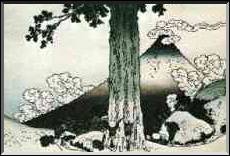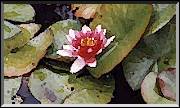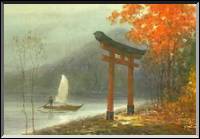 Haiku is one of the most important forms of traditional Japanese poetry. Haiku poems can describe almost anything, but you seldom find themes which are too complicated for
normal people's recognition and understanding. Some of the most thrilling Haiku poems describe daily
situations in a way that gives the reader a brand new experience of a well-known situation.
Haiku is one of the most important forms of traditional Japanese poetry. Haiku poems can describe almost anything, but you seldom find themes which are too complicated for
normal people's recognition and understanding. Some of the most thrilling Haiku poems describe daily
situations in a way that gives the reader a brand new experience of a well-known situation.|
She loves these poems, Word pictures, so clear, so sharp: Seductive bullets. |
 Haiku is, today, a 17-syllable
verse form consisting of three metrical units of 5, 7, and 5 syllables. If you want to try writing some, here are some guidelines.
Haiku must be brief. Use only images of things you can see, smell, taste, touch or feel. Avoid adverbs (words describing the verb or action) and adjectives (words describing the
noun or things). Use modifiers only to make your haiku images more exact and precise. Let us know if that gate is a garden
gate, a prison gate or a swinging gate. Many adverbs and adjectives imply judgment (beautiful, graceful, ugly) so by
avoiding them, and more importantly — your own opinion, the haiku is left with images of things just as they are.
Haiku is, today, a 17-syllable
verse form consisting of three metrical units of 5, 7, and 5 syllables. If you want to try writing some, here are some guidelines.
Haiku must be brief. Use only images of things you can see, smell, taste, touch or feel. Avoid adverbs (words describing the verb or action) and adjectives (words describing the
noun or things). Use modifiers only to make your haiku images more exact and precise. Let us know if that gate is a garden
gate, a prison gate or a swinging gate. Many adverbs and adjectives imply judgment (beautiful, graceful, ugly) so by
avoiding them, and more importantly — your own opinion, the haiku is left with images of things just as they are.
|
Majestic antlers rising from the lily pond; glint from a rifle |
Haiku are simple. Often beginners try to put too much into it. A good rule is to have at least two concrete images, no more than three. Some schools of haiku are happy with a couple of images which paint a lovely scene wherein your mind can wander and wonder.
|
After the storm A boy wiping the sky From the tables. |

Enjoy one more Haiku poem:
|
No sky no earth - but still snowflakes fall |